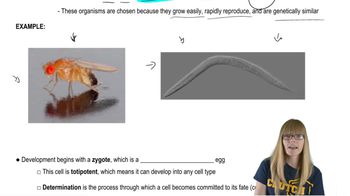Table of contents
- 1. Introduction to Genetics51m
- 2. Mendel's Laws of Inheritance3h 37m
- 3. Extensions to Mendelian Inheritance2h 41m
- 4. Genetic Mapping and Linkage2h 28m
- 5. Genetics of Bacteria and Viruses1h 21m
- 6. Chromosomal Variation1h 48m
- 7. DNA and Chromosome Structure56m
- 8. DNA Replication1h 10m
- 9. Mitosis and Meiosis1h 34m
- 10. Transcription1h 0m
- 11. Translation58m
- 12. Gene Regulation in Prokaryotes1h 19m
- 13. Gene Regulation in Eukaryotes44m
- 14. Genetic Control of Development44m
- 15. Genomes and Genomics1h 50m
- 16. Transposable Elements47m
- 17. Mutation, Repair, and Recombination1h 6m
- 18. Molecular Genetic Tools19m
- 19. Cancer Genetics29m
- 20. Quantitative Genetics1h 26m
- 21. Population Genetics50m
- 22. Evolutionary Genetics29m
14. Genetic Control of Development
Developmental Patterning Genes
Problem 26
Textbook Question
In land plants, there is an alternation of generations between a haploid gametophyte generation and a diploid sporophytic generation. Both generations are typically multicellular and may be free-living. The male (pollen) and female (embryo sac) gametophytes are the haploid generation of flowering plants.
How would you conduct a screen to identify genes required for male gametophyte development?
 Verified step by step guidance
Verified step by step guidance1
Understand the problem: The goal is to identify genes required for male gametophyte development in flowering plants. Male gametophytes (pollen) are haploid and develop from microspores produced by meiosis in the diploid sporophyte. The process involves multiple stages, including microspore formation, mitotic divisions, and pollen maturation.
Design a genetic screen: To identify genes involved in male gametophyte development, you can use a mutagenesis approach. Treat seeds or plants with a mutagen (e.g., EMS or radiation) to induce random mutations in the genome. Grow the plants to maturity to produce seeds containing potential mutants.
Focus on male gametophyte-specific phenotypes: Collect pollen from the mutagenized plants and examine it under a microscope for abnormalities in development, such as defects in pollen shape, size, or viability. You can also test pollen germination and tube growth in vitro to identify functional defects.
Use genetic analysis to confirm mutations: Cross the plants with defective pollen to wild-type plants. If the mutation affects male gametophyte development, you may observe reduced transmission of the mutant allele through the male gametes. Perform reciprocal crosses to confirm that the defect is specific to the male gametophyte.
Map and identify the mutated gene: Use molecular techniques such as positional cloning or whole-genome sequencing to identify the gene responsible for the observed phenotype. Once identified, analyze the gene's expression pattern and function to confirm its role in male gametophyte development.
 Verified video answer for a similar problem:
Verified video answer for a similar problem:This video solution was recommended by our tutors as helpful for the problem above
Video duration:
1mPlay a video:
Was this helpful?
Key Concepts
Here are the essential concepts you must grasp in order to answer the question correctly.
Alternation of Generations
Alternation of generations is a reproductive cycle in land plants that involves two distinct multicellular stages: the haploid gametophyte and the diploid sporophyte. The gametophyte produces gametes through mitosis, while the sporophyte produces spores through meiosis. Understanding this cycle is crucial for identifying genes involved in the development of specific generations, such as the male gametophyte.
Recommended video:
Guided course

Alternative DNA Forms
Gametophyte Development
Gametophyte development refers to the processes that lead to the formation of gametophytes from spores. In flowering plants, the male gametophyte develops into pollen grains, which are essential for fertilization. Identifying genes that regulate this development can provide insights into the mechanisms controlling male gametophyte formation and function.
Recommended video:
Guided course

Genetics of Development
Gene Screening Techniques
Gene screening techniques, such as mutagenesis, gene expression analysis, and genetic mapping, are methods used to identify and characterize genes involved in specific biological processes. In the context of male gametophyte development, these techniques can help isolate genes that are essential for the formation and function of pollen, allowing researchers to understand the genetic basis of this critical stage in plant reproduction.
Recommended video:
Guided course

Mapping Genes
Related Videos
Related Practice
Textbook Question
Homeotic genes are thought to regulate each other.Are similar interactions observed between Hox genes?
354
views


